A Novel Two-Factor Authentication Scheme for Increased Security in Accessing the Moodle E-Learning Platform
Abstract
:1. Introduction
2. Evolution of Digital Certificate
Benefits of Two-Factor Authentication
3. Purpose of the Two-Factor Authentication Method
The Threats That Two-Factor Authentication Addresses
- [1]
- [2]
- Phishing attempts—Hackers often send emails that include links to malicious websites designed to infect a user’s computer or persuade them to enter their passwords. Once obtained, a password can be used by anyone who manages the hacking attempt. 2FA combats phishing by adding a second validation layer after entering the password.
- [3]
- Social engineering—Hackers often simply manipulate users to give up their passwords. By posing as an IT professional at the user’s company, they can gain the user’s trust before asking for login credentials. 2FA protects against this by validating the location and IP of each login attempt after entering a password.
- [4]
- Brute-force attacks—In a brute-force attack, a hacker randomly generates passwords for a particular computer until it matches the correct sequence. The second level of protection of 2FA requires a login attempt to be validated before granting access.
- [5]
- Keylogging—If a user has not written down their password, hackers can use malware to track and copy a user’s password as they write it using the computer keyboard. Hackers track every keystroke and store the password. The second level of validation in 2FA allows a user to ensure that the login attempt is theirs, even if their password has been compromised.
4. Development of the Method with 2FA
- -
- Install the Open SSL program on Windows to generate a certificate and private file.
- -
- Create a local host to run Moodle: install XAMPP, Apache distribution containing MariaDB, PHP, and SQL Server.
- -
- Install Moodle in the local environment; the Windows version of Moodle 311 was installed on our local system.
- -
- Create a script to validate the pfx file.
- -
- Create a script to read the pfx file using open SSL; we created a function named readpfxfile.
- -
- Create a script to read the cert file.
- -
- Create a function to extract the data from the cert file.
- -
- Create a script to upload the pfx certificate and enter the password.
- -
- Create a script to read the uploaded file without moving to any location.
- -
- Create a function read the pfx file.
- -
- Create a script to obtain the certificate data from pfx.
- -
- Create a script to extract the data from the certificate.
- -
- Finish creating a script to read the pfx file and obtain the data-using password.
- -
- Create an authentication plugin that will override the login functionality, as seen in Figure 1.
- -
- Create an authentication plugin structure.
- -
- Create an authentication class to override the login hooks and function to load the login page.
- -
- Create a custom authentication plugin, as seen in Figure 2.
- -
- Extend the Moodle core authentication class.
- -
- Create a function to show the custom page. This line of code is used to redirect to the custom login page.
- -
- Create an authentication plugin with the pfx form upload, as seen in Figure 3.
- -
- Create checks to obtain the user’s data.
- -
- Redirect back to the users if they do not have data with the specific pfx file. Implement the script to obtain the data from the user’s email.
- -
- Create a script to validate the pfx files.
- -
- Overridden login hooks redirect to the login page.
- -
- Create a login page hook and constructor to redirect the pfx and Moodle core login pages.
5. Simulation Results
5.1. Laboratory Studies on Five Two-Factor Authentication Methods Regarding Configuration, Use, and Evaluation by Users
5.2. Analyzing the Impact of the Developed Method
6. Conclusions
Author Contributions
Funding
Institutional Review Board Statement
Informed Consent Statement
Data Availability Statement
Conflicts of Interest
References
- Fan, P.; Liu, Y.; Zhu, J.; Fan, X.; Wen, L. Identity Management Security Authentication Based on Blockchain Technologies. Int. J. Netw. Secur. 2019, 21, 912–917. [Google Scholar]
- Campo, M.; Amandi, A.; Biset, J.C. A software architecture perspective about Moodle flexibility for supporting empirical research of teaching theories. Educ. Inf. Technol. 2021, 26, 817–842. [Google Scholar] [CrossRef] [PubMed]
- Zabolotskikh, A.; Zabolotskikh, A.; Dugina, T.; Tavberidze, D. Creating individual learning paths in the Moodle plugin for undergraduate students to study English grammar. Educ. Inf. Technol. 2021, 26, 617–637. [Google Scholar] [CrossRef]
- Riestra-González, M.; del Puerto Paule-Ruíz, M.; Ortin, F. Massive LMS log data analysis for the early prediction of course-agnostic student performance. Comput. Educ. 2021, 163, 104108. [Google Scholar] [CrossRef]
- Nash, S.S.; Rice, W. Moodle 3 E-Learning Course Development; Packt Publishing Ltd.: Birmingham, UK, 2017; ISBN 978-1-78847-219-7. [Google Scholar]
- Ranjha, A.; Javed, M.A.; Srivastava, G.; Lin, J.C.W. Intercell Interference Coordination for UAV enabled URLLC with perfect/imperfect CSI using cognitive radio. IEEE Open J. Commun. Soc. 2022, 4, 197–208. [Google Scholar] [CrossRef]
- Asim, J.; Khan, A.S.; Saqib, R.M.; Abdullah, J.; Ahmad, Z.; Honey, S.; Afzal, S.; Alqahtani, M.S.; Abbas, M. Blockchain-based Multifactor Authentication for Future 6G Cellular Networks: A Systematic Review. Appl. Sci. 2022, 12, 3551. [Google Scholar] [CrossRef]
- Vinoth, R.; Deborah, L.J.; Vijayakumar, P.; Gupta, B.B. An Anonymous Pre-Authentication and Post-Authentication Scheme Assisted by Cloud for Medical IoT Environments. IEEE Trans. Netw. Sci. Eng. 2022, 9, 3633–3642. [Google Scholar] [CrossRef]
- Sharma, P.; Agarwal, K.; Chaudhary, P.J.I.J. E-learning platform security issues and their prevention techniques: A review. Int. J. 2021. [Google Scholar] [CrossRef]
- Nassani, A.A.; Grigorescu, A.; Yousaf, Z.; Trandafir, R.A.; Javed, A.; Haffar, M. Leading Role of E-Learning and Blockchain towards Privacy and Security Management: A Study of Electronics Manufacturing Firms. Electronics 2023, 12, 1579. [Google Scholar] [CrossRef]
- Shahzad, K.; Aseeri, A.O.; Shah, M.A. A Blockchain-Based Authentication Solution for 6G Communication Security in Tactile Networks. Electronics 2022, 11, 1374. [Google Scholar] [CrossRef]
- Rafat, K.; Laila, S.R.; Ashiqul, I.A.; Akter, K.T.; Tabassum, M.; Sagar, H. Digital Signature Authentication for a Bank Using Asymmetric Key Cryptography Algorithm and Token Based Encryption. In Evolutionary Computing and Mobile Sustainable Networks; Springer: Singapore, 2020; pp. 853–859. [Google Scholar] [CrossRef]
- Selvam, P.M.; Sujatha, S.S. A study on integrity and authentication using rsa and sha-3 algorithms for secured data communication. Int. J. Eng. Sci. Math. 2020, 9, 1–18. [Google Scholar]
- Mihailescu, M.I.; Nita, S.L.; Corneliu, P.V. Applied Cryptography In Designing E-Learning Platforms. In Proceedings of the International Scientific Conference eLearning and Software for Education, Bucharest, Romania, 23–24 April 2020. [Google Scholar] [CrossRef]
- Hutain, J.; Michinov, N. Improving student engagement during in-person classes by using functionalities of a digital learning environment. Comput. Educ. 2022, 183, 104496. [Google Scholar] [CrossRef]
- Guo, J.; Li, C.; Zhang, G.; Sun, Y.; Bie, R. Blockchain-enabled digital rights management for multimedia resources of online education. Multimed. Tools Appl. 2020, 79, 9735–9755. [Google Scholar] [CrossRef]
- Fayziyeva, D.S.; Yuldasheva, N.S.; Islomov, S.Z. Security issues in E-Learning system. In Proceedings of the International Conference on Information Science and Communications Technologies (ICISCT), Tashkent, Uzbekistan, 4–6 November 2019. [Google Scholar] [CrossRef]
- Jagadamba, G.; Sheeba, R.; Brinda, K.N.; Rohini, K.C.; Pratik, S.K. Adaptive E-Learning Authentication and Monitoring. In Proceedings of the 2nd International Conference on Innovative Mechanisms for Industry Applications (ICIMIA), Bangalore, India, 5–7 March 2020. [Google Scholar] [CrossRef]
- Korać, D.; Damjanović, B.; Simić, D. A model of digital identity for better information security in e-learning systems. J. Supercomput. 2022, 78, 3325–3354. [Google Scholar] [CrossRef]
- Nurhaida, I.; Ramayanti, D.; Riesaputra, R. Digital signature & encryption implementation for increasing authentication, integrity, security and data non-repudiation. IRJCS Int. Res. J. Comput. Sci. 2017, 4, 4–14. [Google Scholar]
- Wang, L.; Song, T. An Improved Digital Signature Algorithm and Authentication Protocols in Cloud Platform. In Proceedings of the IEEE International Conference on Smart Cloud (SmartCloud), New York, NY, USA, 18–20 November 2016. [Google Scholar] [CrossRef]
- AlQahtani, A.A.S.; El-Awadi, Z.; Min, M. A Survey on User Authentication Factors. In Proceedings of the 2021 IEEE 12th Annual Information Technology, Electronics and Mobile Communication Conference (IEMCON), Vancouver, BC, Canada, 27–30 October 2021; pp. 0323–0328. [Google Scholar] [CrossRef]
- Gordin, I.; Graur, A.; Potorac, A. Two-factor authentication framework for private cloud. In Proceedings of the 2019 23rd International Conference on System Theory, Control and Computing (ICSTCC), Sinaia, Romania, 9–11 October 2019; pp. 255–259. [Google Scholar] [CrossRef]
- Ozkan, C.; Bicakci, K. Security Analysis of Mobile Authenticator Applications. In Proceedings of the 2020 International Conference on Information Security and Cryptology (ISCTURKEY), Ankara, Turkey, 3–4 December 2020; pp. 18–30. [Google Scholar] [CrossRef]
- Hassan, M.M.; Nipa, S.S.; Akter, M.; Haque, R.; Deepa, F.N.; Rahman, M.; Siddiqui, M.S.; Sharif, M.H. Broken Authentication and Session Management Vulnerability: A Case Study of Web Application. Int. J. Simul. Syst. Sci. Technol. 2018, 1. [Google Scholar] [CrossRef]
- Certic, S. Two-Factor Authentication Vulnerabilities. SSRN Electron. J. 2018. [Google Scholar] [CrossRef]
- Grassi, P.; Garcia, M.E.; Fenton, J.L. Digital Identity Guidelines; National Institute of Standards and Technology, U.S. Department of Commerce: Gaithersburg, MD, USA, 2017. [CrossRef]
- Tirfe, D.; Anand, V.K. A Survey on Trends of Two-Factor Authentication. In Contemporary Issues in Communication, Cloud and Big Data Analytics; Sarma, H.K.D., Balas, V.E., Bhuyan, B., Dutta, N., Eds.; Lecture Notes in Networks and Systems; Springer: Singapore, 2022; Volume 281. [Google Scholar] [CrossRef]
- Reese, K.; Smith, T.; Dutson, J.; Armknecht, J.; Cameron, J.; Seamons, K. A Usability Study of Five Two-Factor Authentication Methods. In Proceedings of the Fifteenth Symposium on Usable Privacy and Security, Santa Clara, CA, USA, 12–13 August 2019; ISBN 978-1-939133-05-2. [Google Scholar]
- Das, S.; Dingman, A.; Camp, L.J. Why Johnny Doesn’t Use Two Factor: A Two-Phase Usability Study of the FIDO U2F Security Key. In Proceedings of the 2018 International Conference on Financial Cryptography and Data Security (FC), Nieuwpoort, Curaçao, 26 February–2 March 2018. [Google Scholar]
- Acemyan, C.; Kortum, P.; Xiong, J.; Wallach, D. 2fa might be secure, but it’s not usable: A summative usability assessment of google’s two-factor authentication (2fa) methods. In Proceedings of the Human Factors and Ergonomics Society Annual Meeting; Sage: Los Angeles, CA, USA, 2018. [Google Scholar]
- Lang, J.; Czeskis, A.; Balfanz, D.; Schilder, M.; Srinivas, S. Security Keys: Practical Cryptographic Second Factors for the Modern Web. In Proceedings of the International Conference on Financial Cryptography and Data Security (FC), Christ Church, Barbados, 22–26 February 2016; Springer: Berlin/Heidelberg, Germany, 2016; pp. 422–440. [Google Scholar]
- Reynolds, J.; Smith, T.; Reese, K.; Dickinson, L.; Ruoti, S.; Seamons, K. A Tale of Two Studies: The Best and Worst of YubiKey Usability. In Proceedings of the 2018 IEEE Symposium on Security and Privacy (SP), San Francisco, CA, USA, 20–24 May 2018. [Google Scholar]
- Murtaza, M.H.; Tahir, H.; Tahir, S.; Alizai, Z.A.; Riaz, Q.; Hussain, M. A portable hardware security module and cryptographic key generator. J. Inf. Secur. Appl. 2022, 70, 103332. [Google Scholar] [CrossRef]
- Widup, S.; Pinto, A.; Hylender, D.; Bassett, G.; Langlois, P. 2021 Verizon Data Breach Investigations Report. 2021. Available online: https://www.researchgate.net/publication/351637233_2021 (accessed on 9 March 2022).
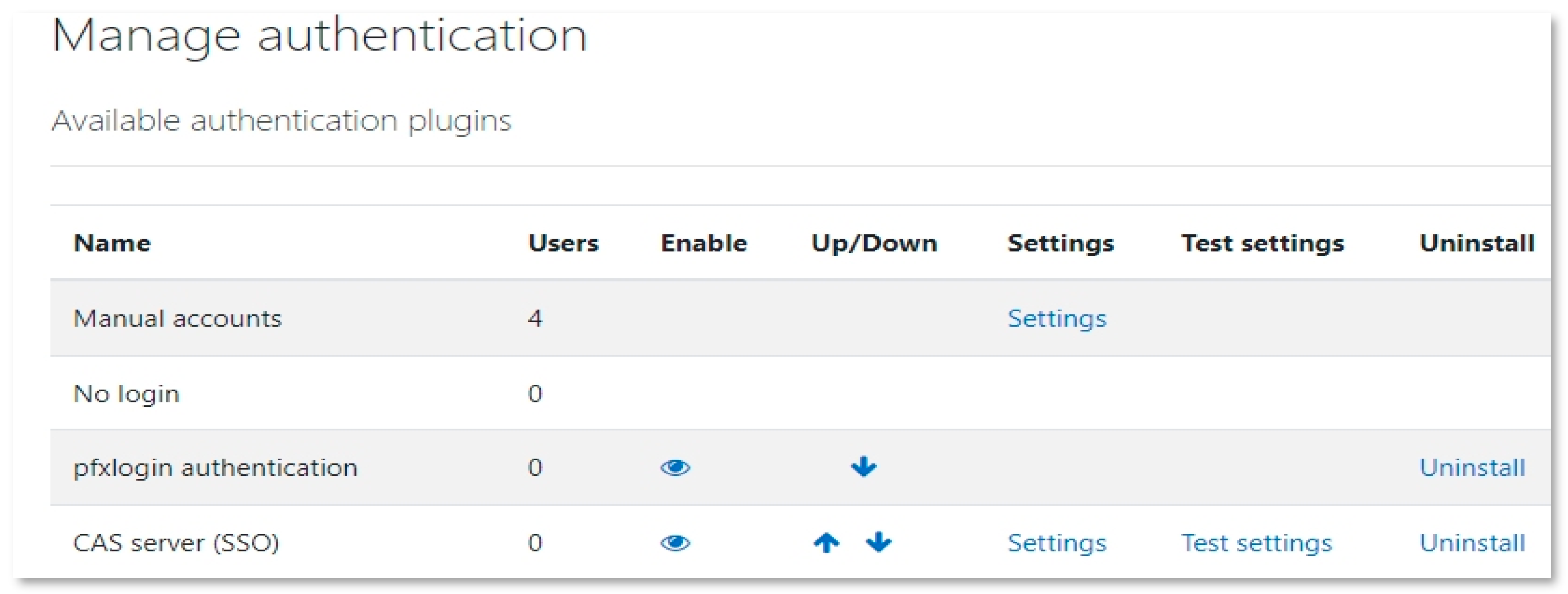
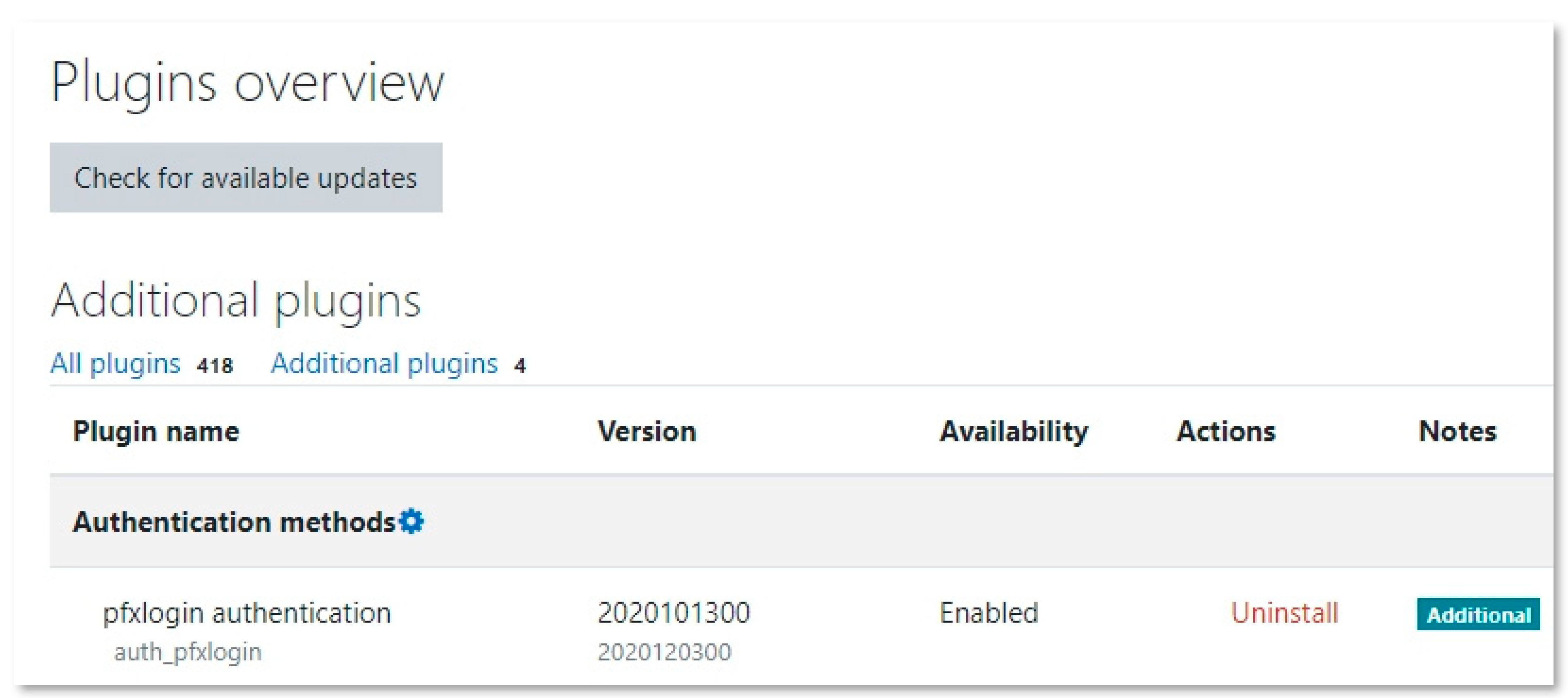
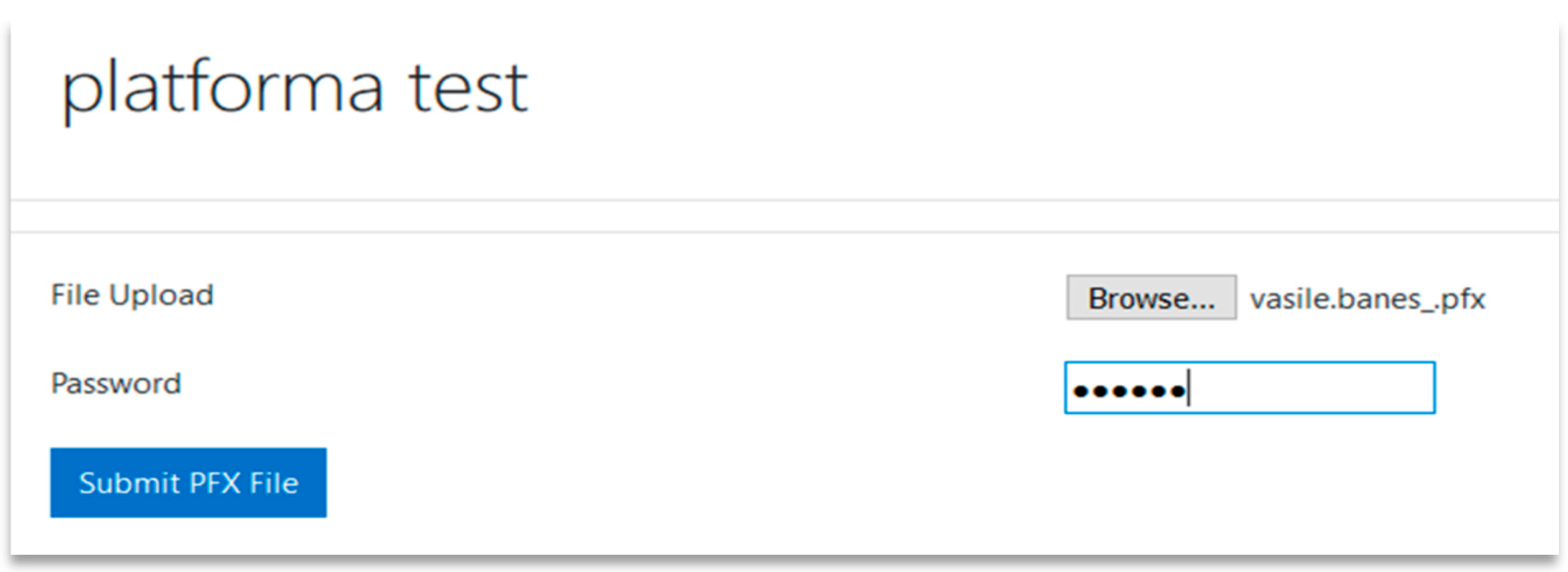
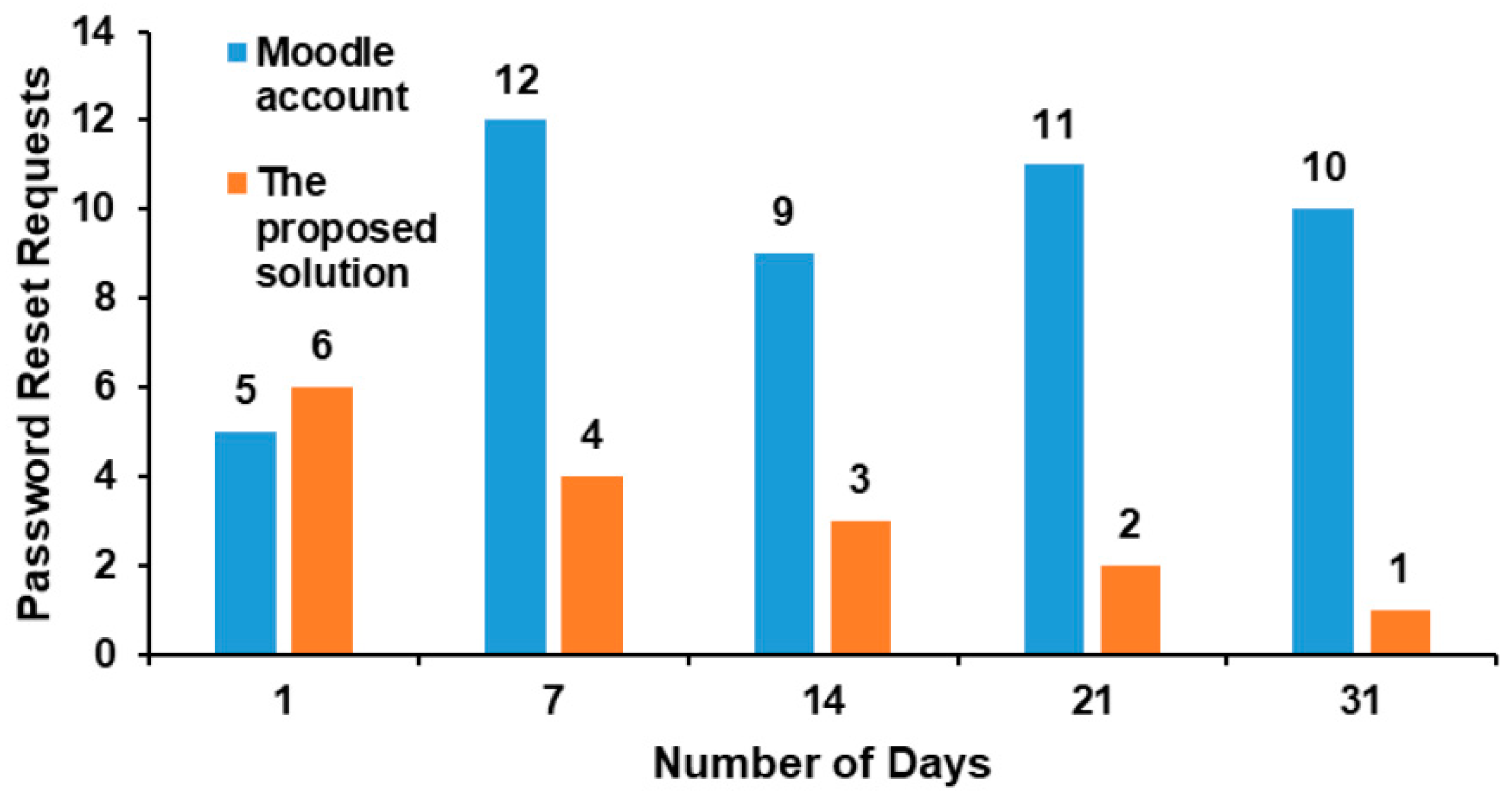
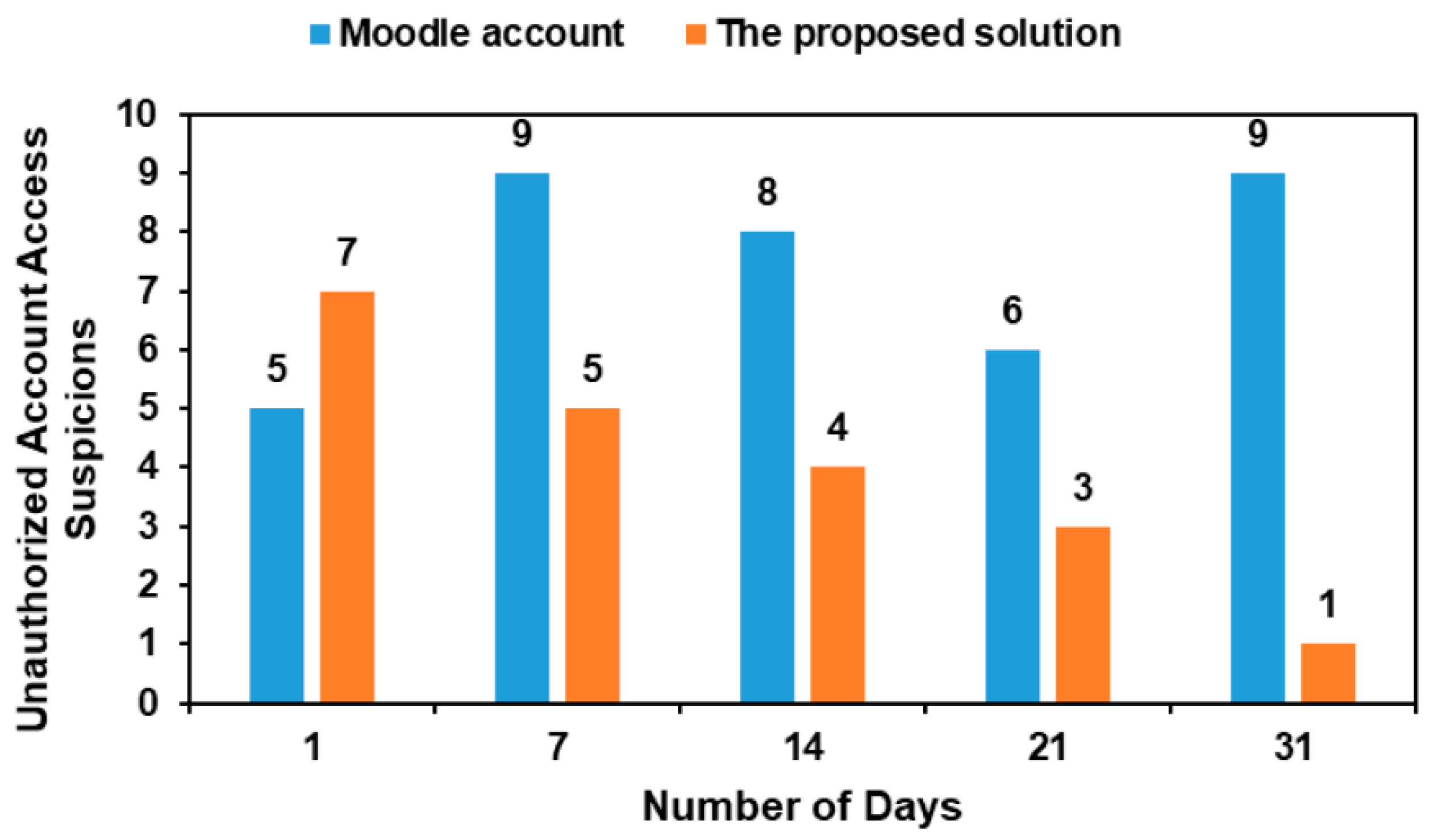
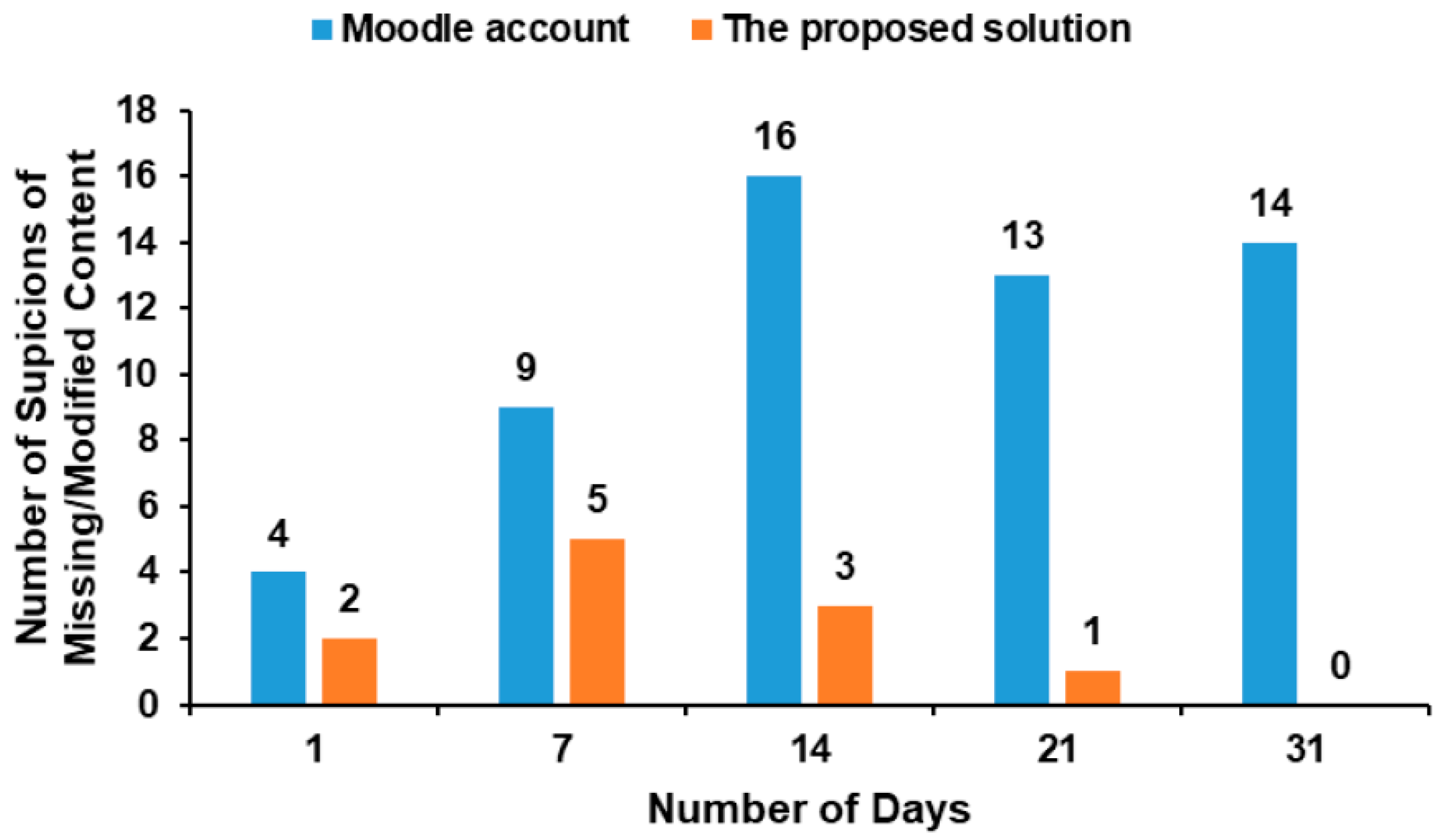
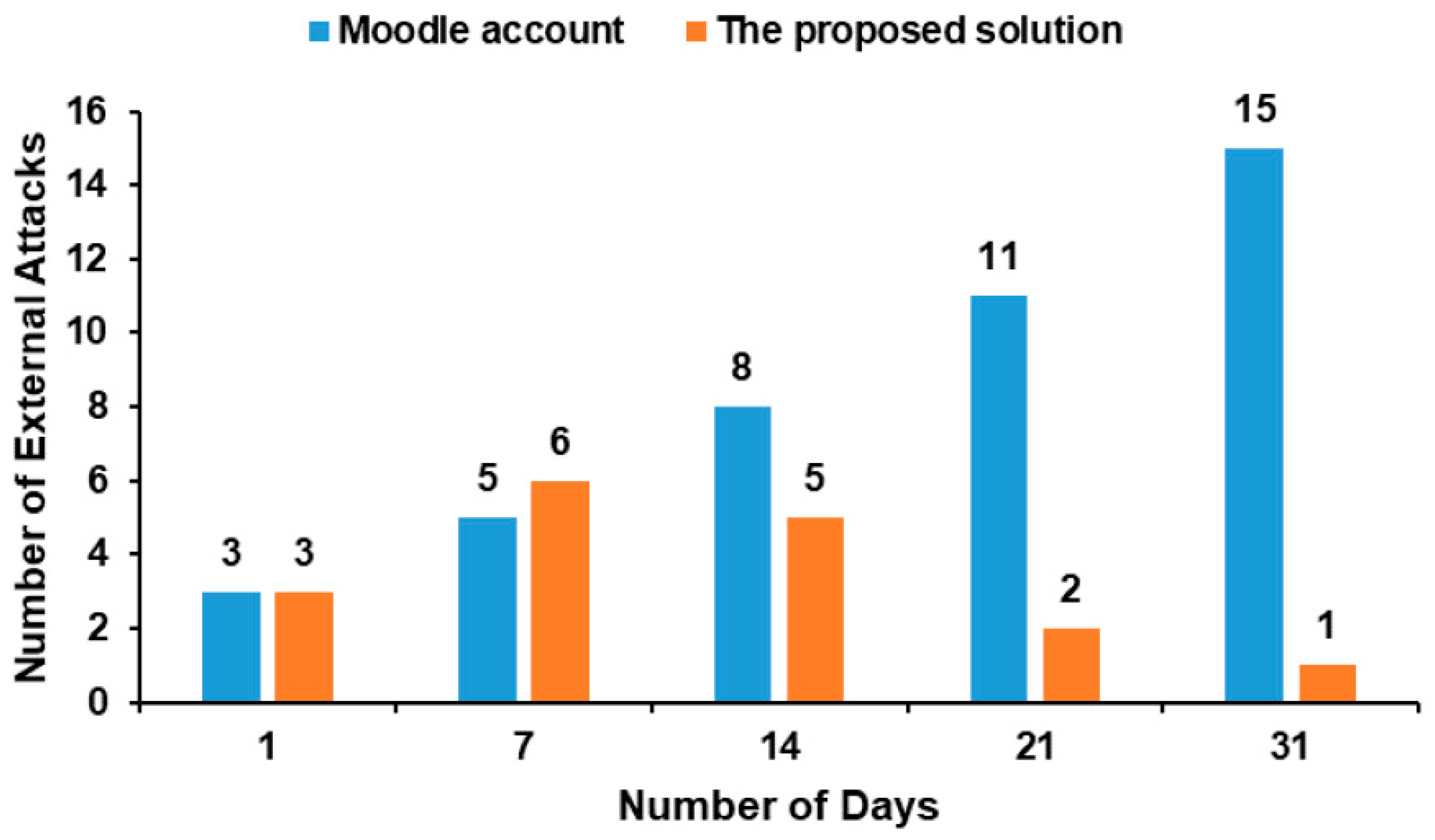
| Authentication Methods | Moodle Platform | Chamilo Platform | Canvas Platform | Blackboard Platform |
|---|---|---|---|---|
| Two-factor authentication based on the name and password of the Moodle account and digital certificate issued by a certification authority (proposed method) | × | × | × | × |
| Single sign-on (SSO) | √ | √ | √ | √ |
| Lightweight directory access protocol (LDAP) | √ | √ | √ | √ |
| Email-based self-registration | √ | × | √ | × |
| Default internal authenticator | √ | √ | √ | √ |
| Web services authentication | √ | √ | × | × |
| External database | √ | × | √ | × |
| Shibboleth | √ | √ | × | √ |
| Central authentication service (CAS) | √ | √ | √ | √ |
| Two-Factor Authentication (2FA) | Advantages | Disadvantage |
|---|---|---|
| 2FA based on SMS text messages and voice |
|
|
| Push notification for 2FA |
|
|
| Software tokens for 2FA/Authenticator App/TOTP 2FA |
|
|
| Hardware tokens for 2FA |
|
|
| Biometric 2FA |
|
|
| 2FA by email |
|
|
Disclaimer/Publisher’s Note: The statements, opinions and data contained in all publications are solely those of the individual author(s) and contributor(s) and not of MDPI and/or the editor(s). MDPI and/or the editor(s) disclaim responsibility for any injury to people or property resulting from any ideas, methods, instructions or products referred to in the content. |
© 2023 by the authors. Licensee MDPI, Basel, Switzerland. This article is an open access article distributed under the terms and conditions of the Creative Commons Attribution (CC BY) license (https://creativecommons.org/licenses/by/4.0/).
Share and Cite
Baneş, V.; Ravariu, C.; Appasani, B.; Srinivasulu, A. A Novel Two-Factor Authentication Scheme for Increased Security in Accessing the Moodle E-Learning Platform. Appl. Sci. 2023, 13, 9675. https://doi.org/10.3390/app13179675
Baneş V, Ravariu C, Appasani B, Srinivasulu A. A Novel Two-Factor Authentication Scheme for Increased Security in Accessing the Moodle E-Learning Platform. Applied Sciences. 2023; 13(17):9675. https://doi.org/10.3390/app13179675
Chicago/Turabian StyleBaneş, Vasile, Cristian Ravariu, Bhargav Appasani, and Avireni Srinivasulu. 2023. "A Novel Two-Factor Authentication Scheme for Increased Security in Accessing the Moodle E-Learning Platform" Applied Sciences 13, no. 17: 9675. https://doi.org/10.3390/app13179675
APA StyleBaneş, V., Ravariu, C., Appasani, B., & Srinivasulu, A. (2023). A Novel Two-Factor Authentication Scheme for Increased Security in Accessing the Moodle E-Learning Platform. Applied Sciences, 13(17), 9675. https://doi.org/10.3390/app13179675










